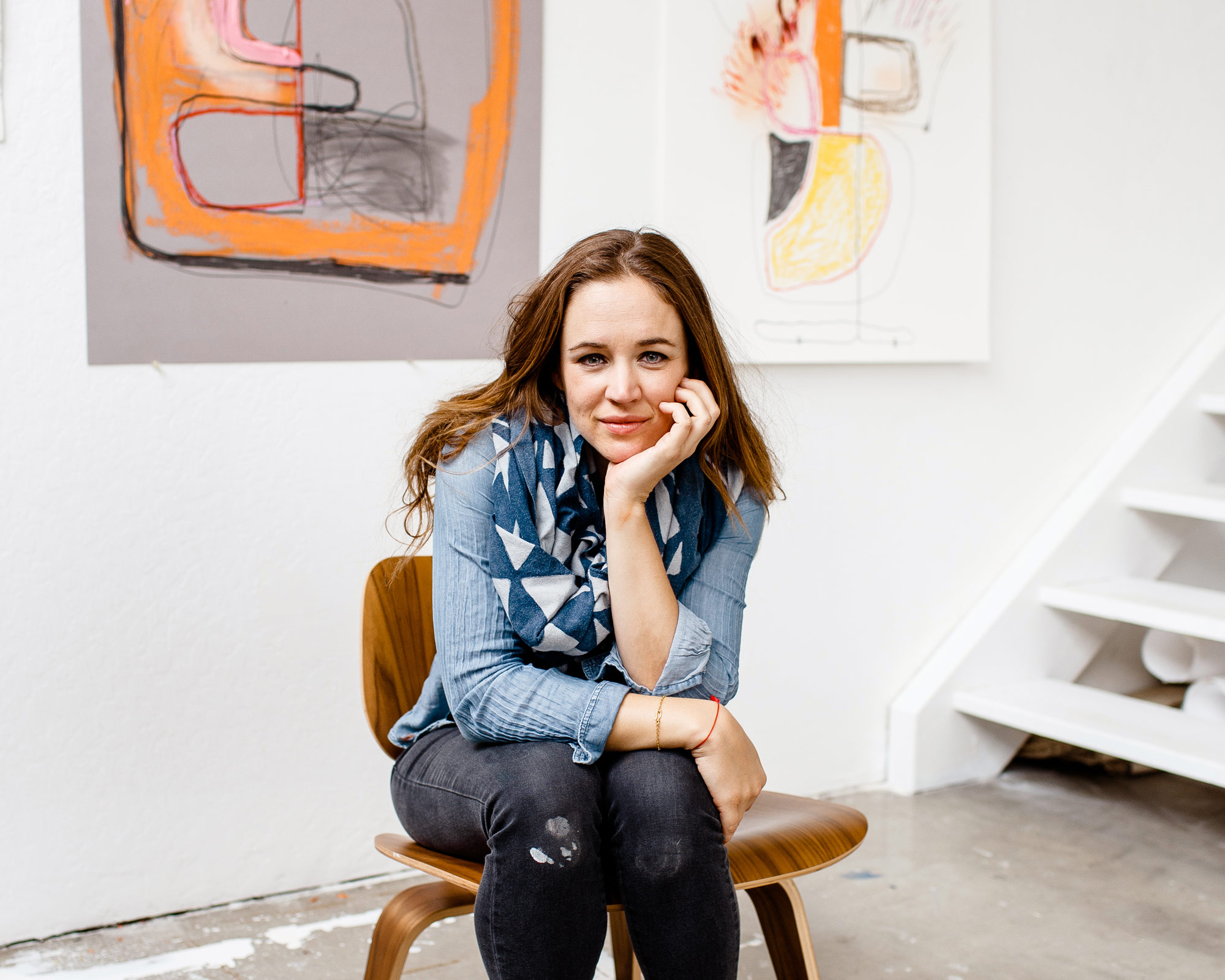
- Interview by Ryan Essmaker October 22, 2013
- Photo by Ike Edeani
Elle Luna
- artist
- designer
Elle Luna works in her studio, where she paints, draws, and experiments. Prior to making art, she worked with incredible teams to design and build Mailbox‘s iPhone app, redesign Uber‘s iOS app that allows people to hail a black car, and scale the storytelling platform, Medium. Before startups, Elle spent five years at IDEO where she worked across a variety of industries to develop multi-channel, holistic experiences with massive impact.
Interview
 Editor’s note: An updated version of this interview, including new images and work, is featured in print in The Great Discontent, Issue One, available in our online shop.
Editor’s note: An updated version of this interview, including new images and work, is featured in print in The Great Discontent, Issue One, available in our online shop.
Ryan: So, what are you up to?
Right now I’m making a giant mess. I’m in that liminal place between where I’ve been and where I’m going, and it’s a little uncomfortable and a little scary, but I’m sticking there until I know exactly which direction I’m headed next.
You’re doing some art, right?
Ah! Categories. I can give you categories. I’m a bit all over the place, but am doing a lot of art stuff, yes, including painting. I just had my first solo art show in San Francisco in May. I’m also loving doing very encapsulated, contained projects with startups. For example, I just finished a project with Uber. I like working with the people I love on projects that I love for a focused period of time.
What kind of stuff do you do with them?
Everything from product to brand to design thinking and user experience.
Cool.
Yeah, and I just joined Dropbox for their hack week. A group of us got to wreak havoc and make stuff that we felt should be out in the world. Now I’m here in New York working on a new project with textiles and fashion. Prior to New York, I had went to Bali for six weeks to take a break because I was exhausted after my art show. Before that, I had worked at Mailbox, but after it launched, I stepped away to pursue painting full-time. When I went to Bali, there were these incredibly gifted artisans who were riffing on my paintings in fabric. Right before I left to fly back to San Francisco, they gave me all these samples and I was like, “Oh, gosh, what have I stumbled onto?” That’s been marinating in the background while I’ve been doing little projects with startups and portrait work. Now I’m in New York, figuring out what it would look like to work with textiles.
Now I’m interested in hearing the rest of your story.
This is a good time to chat because I’ve left so many dream jobs and now I’m floating in the ether of the unknown. The more I talk about it, the more I hear, “Me too!” from folks. That’s what led me to be really public about it on Instagram. A friend of mine said, “When are you going to stop taking pictures of sunsets and architecture and actually start sharing your life? You’re painting all the time. Why don’t you share your creative process?” Well, that really got me thinking, and the very next day I decided to give it a go.
On the way to work that morning, I met a man on the train. He had this wonderful handlebar mustache and we got to chatting. It turned out that he was a prosecuting attorney who had retired and was now volunteering at a soup kitchen. I painted his portrait with watercolors and posted it on Instagram and it was the scariest moment because it was something people didn’t expect me to do. Plus, sometimes my watercolors look like a 5-year-old did them. The comments flooded in and I thought, “Okay, I’m going to start showing my real life.” That’s when I started sharing my creative process.
How long ago was that?
I think it was about a year ago.
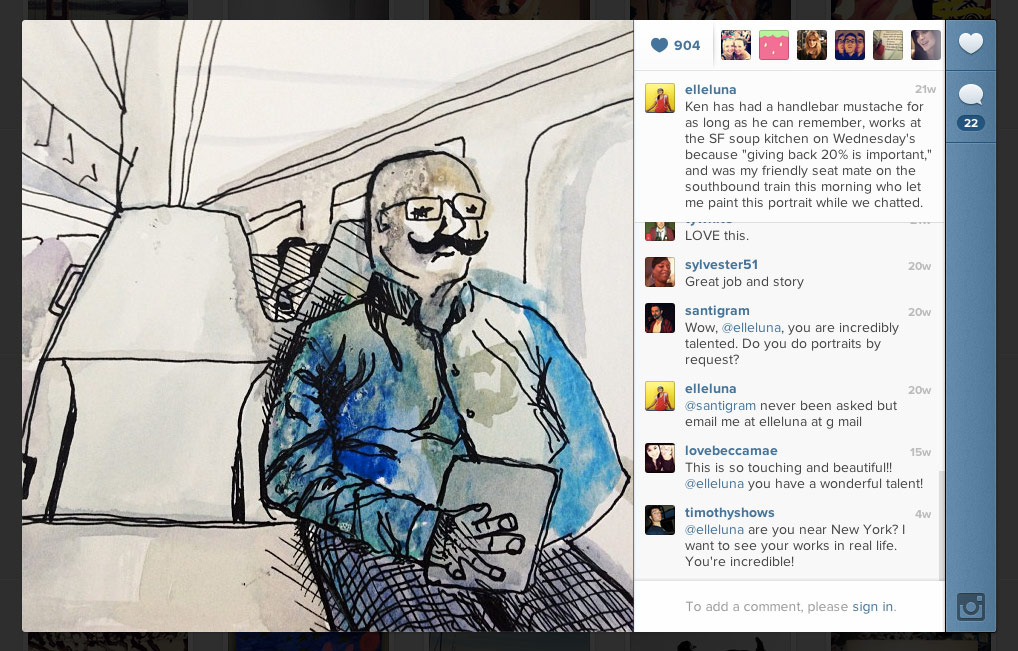
“I actually come from a long line of lawyers…in my senior year of college, I decided to be a lawyer. I applied to nine law schools…one after another, I received nine rejection letters…if I had gotten in, I would’ve gone.”
I want to hear about your path to what you’re doing now.
Do you want me to start at childhood?
You can go as far back as you want.
I was born in Dallas, Texas, and lived there for 18 years. Looking back on it now, I understand that growing up there was foundational for what I’m doing—I’ll come back to that.
After high school, I decided to go to Nashville, TN, for college because, being a kid from Texas, Nashville sounded really exotic. I haphazardly got into an art program at Vanderbilt, where I was able to try my hand at sculpture, painting, visual arts, and audio work. It was very freeform and I got to experiment in a really unfettered, authentic way. That led to tons of work that came from a very raw, naïve place.
During my senior year of college, I was trying to figure out what to do next. I actually come from a long line of lawyers and, for me, there was something romantic about being a lawyer because I had grown up watching my dad argue cases. When I was young, my mom would pull me out of school and my brother and I would get dressed up and go hear my dad make closing arguments for a case. There was something amazing about sitting on those wooden benches and seeing my dad be a great storyteller—that’s effectively what it is, and it’s so creative. I remember thinking, “Oh, that’s what I want to do.” So, in my senior year of college, I decided to be a lawyer. I applied to nine law schools, but when I wrote my admissions essays, I must have said something like, “I don’t want to do this. Please don’t accept me,” (laughing) because one after another, I received nine rejection letters from all the law schools I had applied to. In my defense, I think I was qualified to get into at least one of the nine I had applied to. But if I had gotten in, I would’ve gone.
Around that time, I was making all kinds of video work and someone very close to me suggested that I apply to art school. I quietly applied to two art programs: The Rhode Island School of Design (RISD) and The Art Institute of Chicago, and I was accepted into both. This was clue number one that the universe was trying to put me on the right path. I chose The Art Institute of Chicago because the program was looser, less structured. I did a three-year MFA program, starting in film, but halfway through, I realized I was much more interested in storytelling than the actual medium of film. I decided to switch to design and finished my degree focusing on conceptual storytelling.
I started looking for jobs online prior to graduation and had heard about IDEO. When I looked to see if they had any jobs in their Chicago area office, I found a posting that said, “in search of storyteller.” I remember thinking, “The stars have aligned. That is my job. I have arrived.” I applied and went in to interview, and they invited the entire office of like 50 people to hear me! I was so terrified. However, I had prepared to make it a fun experience and only included work that was overly conceptual, totally unresolved, and asked more questions than it gave answers. I presented to everyone, got the job, and started working there two weeks later.
Did you work at their Chicago location the whole time?
I eventually transferred to our San Francisco office. Working at IDEO was incredible. You know that book, All I Really Need to Know I Learned in Kindergarten? I feel like I can say, “Everything I ever learned about life I learned at IDEO.” I learned how to work with people, how to gain empathy for those I was designing for; I learned about methodology and process; and my worldview opened up. If anybody wants to do design consulting, IDEO is the only place to go.
After a few years in San Francisco, I was becoming more and more interested in startups because I was around them all the time. I wanted to work full-time with startups, so I left IDEO, even though it was a dream job. I called my parents and told them I left the job that they were so excited about and that I was unemployed and had nothing lined up, but that I thought it would be better in the long run—they were very concerned.
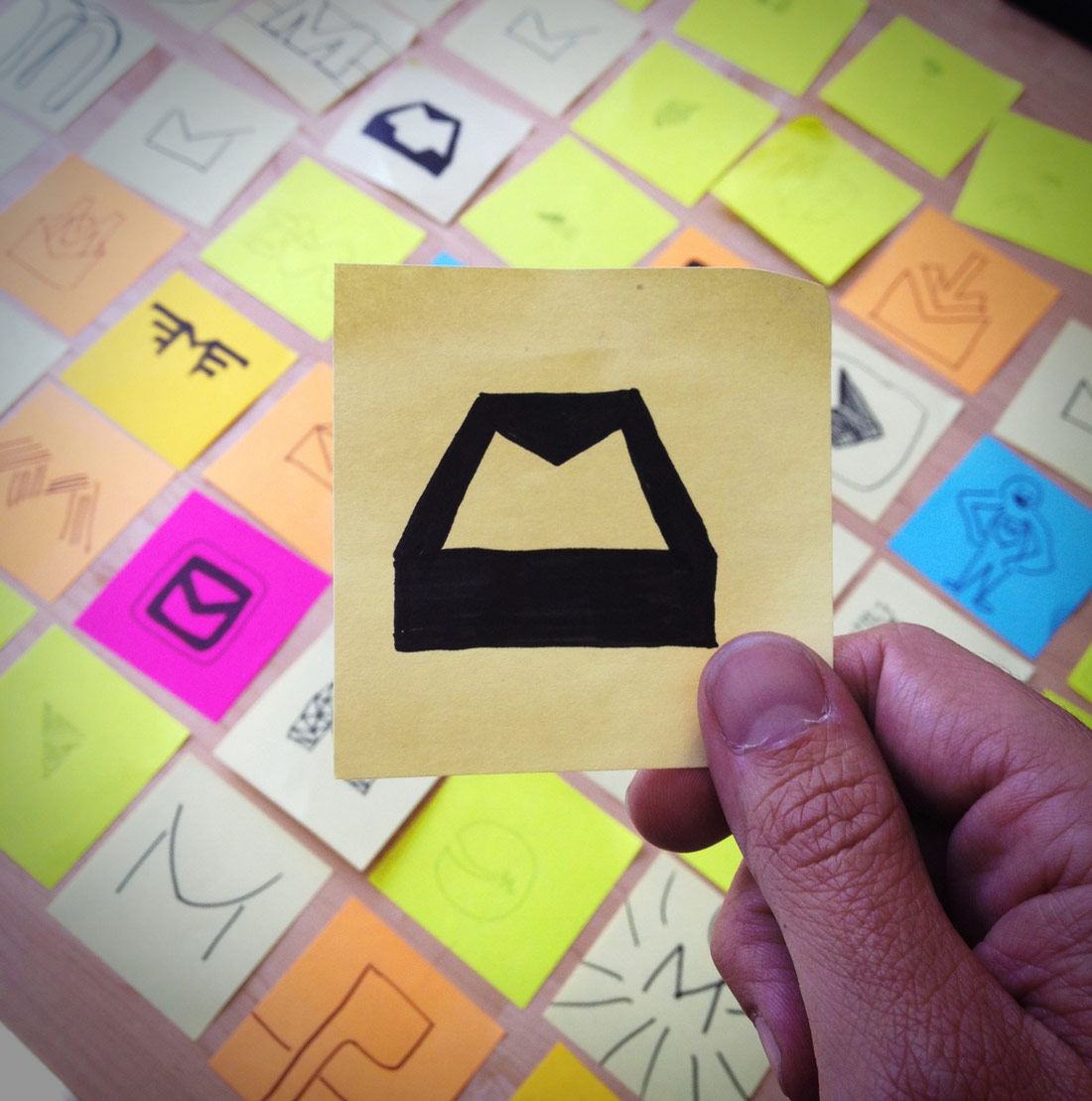
“…it was such a huge learning curve to take an idea on a post-it note all the way to an implemented product. Working at Mailbox felt a bit like climbing Mount Everest. Our goal to redesign email was so audacious that it rallied all the troops.”
You quit your job at IDEO without knowing what you would do next?
Yes—it was terrifying. And it was sad because I loved the people who I worked with.
But I had this nagging question: What if we could take all of the firepower that we give to Fortune 500 companies—you know, to help them disrupt markets and create incredible innovation—and, instead, give it to a startup? Seriously. It almost felt unfair! I started talking with a friend about it, telling him what I wanted to do. At the time, he was CEO for a product called Orchestra, which was a shared to-do list app for the iPhone. They were trying to figure out how to grow their product, and I came in to help. That’s when we came up with the idea of redesigning email. I was just a consultant at the time and, on the spot, I was like, “Put me in, coach. I’m ready!” And I joined the Mailbox team.
Oh, I forgot to mention that I had a three week gig with Uber before I joined the Mailbox team—this is where things get crazy! So I was using Uber all the time in San Francisco, even though I hated the design. And then I went to the Crunchies awards ceremony and at a post-ceremony event, where I was in a ball gown, I saw the CEO of Uber, Travis Kalanick, sitting at the bar. I was three whiskeys deep at this point and I walked up to him and said, “I use Uber all the time and I absolutely hate the app. I think you should bring me in to fix it.” He replied, “Oh, yeah? What are the three things you’d fix about it?” I said, “I’d redo the logo, redo the entire app, and change the rating system.” I think there was something about being in a dress that empowered me to say such things. (laughing) And do you know what he said? He said, “Be at the Uber office at 9am on Monday.” I told him I couldn’t do it alone and he said he’d have a team for me.
I thought the offer was bogus, but I went to Uber’s office on Monday at 9am, laughing to myself, and Travis led me back to a project room with two other designers—they were from outside of Uber and he had flown them in from New York! That is the magic of CEOs who get shit done. We took on the Uber app and redesigned it in three weeks. In fact, one of the guys he flew in from New York, Shalin Amin, ended up staying on full-time. The app is gorgeous and last night it won the Fast Company 2013 Innovation By Design Awards for the transportation category, beating out Mars Rover and Tesla. They’re doing some good stuff at Uber.
So, anyway, after Uber I worked full-time at Mailbox. Man, it was such a huge learning curve to take an idea on a post-it note all the way to an implemented product. Working at Mailbox felt a bit like climbing Mount Everest. Our goal to redesign email was so audacious that it rallied all the troops. It felt a bit like when college football players get drafted their first year out and join the team that goes all the way and wins the Superbowl. Mailbox was the first startup I ever worked for, and everything came together so well, surpassing even our most aggressive goals. On top of all of that, Mailbox was acquired by Dropbox. Things were crazy. The team was working so hard, and everyone was so proud. Building Mailbox was a life highlight to be sure.
After that, I called my parents again. I said, “I know we just launched Mailbox yesterday and it’s on CNN and stuff, but I think it’s time for me to move on.”
I’m sensing a trend.
Yeah. They asked what I was going to do and I told them I had no idea. At Mailbox, we had set goals for launch day and the outcomes were off the charts. I remember feeling so proud and inspired by the team, and at the same time, I remember thinking, “That was my goal: to go from post-it note to launch.” And I did it. I had to admit to myself that even though it was going well, designing email wasn’t my life’s work. I was 31, getting older, and could do a lot of things. If email wasn’t my life’s work, then it was time to go do my life’s work.
At Uber, you led the team designing the app. What was your role at Mailbox?
Same kind of thing. I think that, traditionally, I’ve always worked at flat organizations. Even though I was the one to go up to Travis at the bar, it was really a collection of skills that made it happen. It was the same thing with Mailbox. I worked with three other designers and it was really collaborative; everything was team-based.
I left Mailbox on a Wednesday and on Thursday, I got an email from Evan Williams, who asked me to lunch that day. We met up for lunch and by 2:30pm, I was back at Medium, starting a new project. What is with these CEOs who know how to reel you in? I’m really impressed with them. I was at Medium for a few weeks working on a project related to scaling. They saw how we scaled Mailbox and wanted to do the same with Medium. I think Ev’s so talented and I would work with him on anything in a heartbeat.
Anyway, this whole time I was also painting a lot. Some of my paintings were good and some were so freaking horrible. And I was posting all of it, all of it, on Instagram. I just kept finding that the more I put myself out there, the more I received in return. If I wasn’t at Mailbox, I was at home painting. People must have thought I was bonkers because I was either posting photos of icons or of myself at home, covered in paint. Hell, even the dog was covered in paint.
It got to the point where I had one foot in the painting world and one in the startup world, and everyone was losing. I couldn’t fully immerse myself in my paintings to give them what they needed and I couldn’t give my startup work the attention it needed. So I dove into painting full-time. I had no idea what I was doing, but I knew I was on the right path, and that feeling only intensifies with each day.
I think back to the different phases of a project at IDEO—it’s not so different from life, really—I’m in the exploratory, divergent phase. The part where you brainstorm a lot and encourage wild ideas and defer judgement. I believe that the longer you can hang with that ambiguity or unknown, the greater the results will be at the end. This was true for IDEO projects, it was true for Mailbox, and now it is becoming true for my life. I didn’t know what I was going to do with all the art I was creating, but I kept making it anyway.
Then I got offered a pop up show at the Ian Ross Gallery. Ian Ross is a street artist who was one of the early in-house artists at Facebook. Ian and his wife, Daniele, asked me what I was doing with all my work and I said, “Throwing it away or painting over it.” Daniele literally told me, “stop that immediately,” and asked if I’d like to do a three-day pop-up show at the gallery in between official artist shows. That opportunity was game-changing for me. I had three weeks to pull together what was practically a solo show, which included over 60 pieces of work! I felt like a fraud, not a real artist; I couldn’t reconcile how I could be a designer and work in tech and also do art. The week before the show, I invited all of my friends via Facebook and then promptly tried to cancel it—it was too late. It’s one thing to make work, but it’s another thing to have it installed, and invite everyone you know! It turned out to be an incredible experience.
“I think back to the different phases of a project at IDEO—it’s not so different from life, really—I’m in the exploratory, divergent phase. The part where you brainstorm a lot and encourage wild ideas and defer judgement. I believe that the longer you can hang with that ambiguity or unknown, the greater the results will be at the end.”
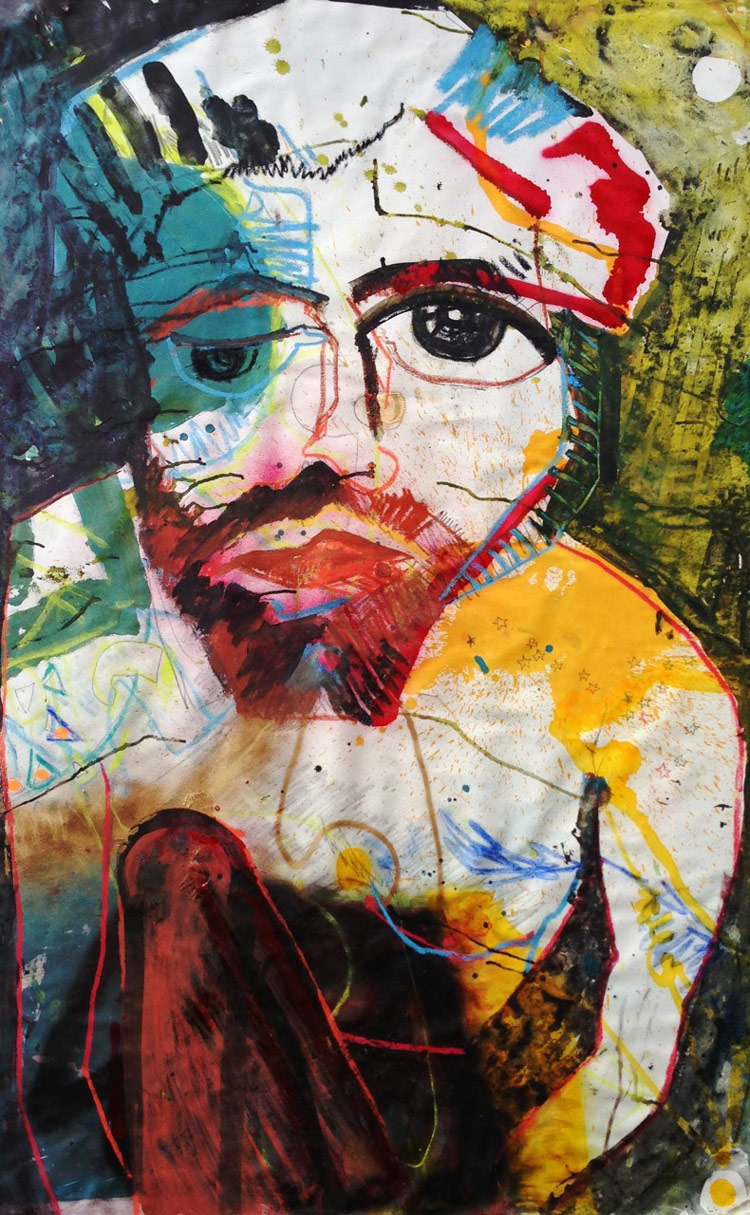
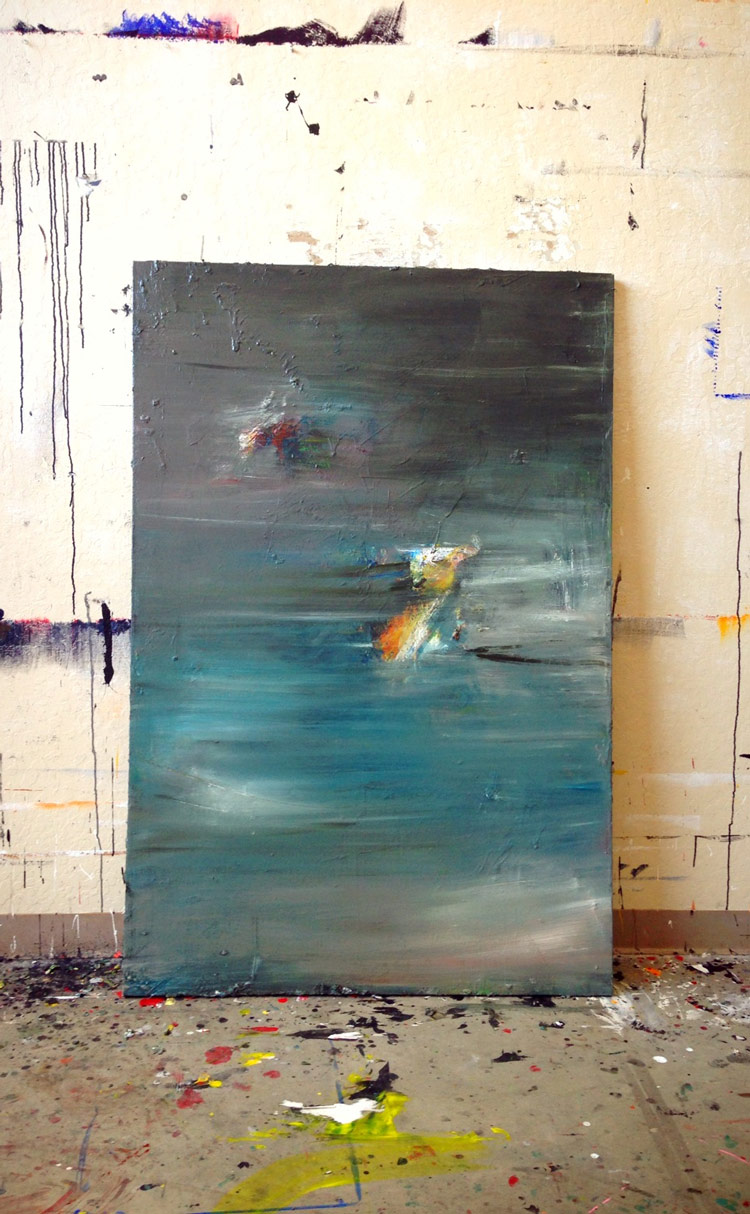
Did you offer pieces for sale at the show?
Yes, all the work was for sale. It felt very much like a family thing and they worked so hard with me to help prepare the show—they stayed up until 4am to perfect the lighting and reshuffle the show a thousand times. I was really worried and told them that nothing might sell, but it felt like we were all in it together, and, of course, the work sold. I’m increasingly learning that I prefer working with people who feel like family.
But I want to experiment with how I do gallery shows going forward, because after scaling Mailbox around the world, having a show felt a bit closed. I didn’t know what to do with that, so I decided to take a break. I went to Bali, rented an incredible Airbnb in the middle of the rice paddies, and had no plans for six weeks. The house I rented was open on three sides, and the rice paddy workers would walk onto the patio to sit in the shade during their breaks. I had all this paper from the supermarket, so one day I started drawing their portraits. I drew over 100 portraits even though none of the people spoke English. I returned to San Francisco totally in love with Airbnb for letting me go to the middle of nowhere and connect with the fabric of a community that way. I’m trying to figure out how to show that work in a way that says thank you to everyone who works at Airbnb, because what they do is amazing. How else could I travel that way or have a transformative experience like that? It’s changing how we experience cultures around the world.
At the end of my time in Bali, I met a few artists who translated my paintings into the most exquisite textiles. When I got back to San Francisco, I worked with a few startups, and all the while, in the back of my mind, I kept dreaming about these textiles. So that’s what brought me to New York. I said to myself, “Elle, you’ve got two weeks to put the pieces together, to see if there’s something here.” It turns out that there is, and I’m aiming to have it launched by Thanksgiving.
That’s an awesome story. So, was creativity part of your childhood?
Yes, so much. My mom and dad are both creative, but in different ways. My dad is a lawyer, but I think it’s creative in that he’s a structuralist. He has to look at incredibly confined problems and find solutions. My mom was one of the early buyers for Neiman Marcus, which is how I think I’m getting this bug for fashion. She has a really good eye and her mom was an artist as well. Because of my parents, my creativity was always really nurtured. I spent a lot of time as a kid making posters, constructing paper dolls, and being weird. I used to build my own overhead projectors and answering machines.
I feel like you mentioned a couple “aha” moments already, but was there a specific moment when you knew what you wanted to do?
I started having a recurring dream about a white room: it had really high ceilings, white walls, industrial windows, and concrete floors. I had the dream over and over again. Finally, a friend of mine said, “Have you ever thought about finding this white room in real life?” I remember feeling stunned by the question. What an obvious thing to ask. I didn’t know what I was looking for or what the role of this white room was. I felt ridiculous.
I started looking at spaces online and one day I was on Craigslist and saw a thumbnail of an apartment—it was the room from my dreams. It was located in San Francisco’s Dogpatch neighborhood and there was an open house that day. I grabbed my checkbook and ran out the door. When I walked into the space, it was crawling with people, but I felt like it was already mine. I walked up to the broker, wrote a check, and left; it was almost an out-of-body experience. A couple of hours later I got a call that I had gotten the apartment. I had no idea what I was doing, but I showed up in the new apartment with two suitcases and my dog. I sat, looked at the space and said aloud, “What in God’s name have I just done? Why I am I here?” As clear as day, the space spoke back to me and said, “It’s time to paint.” That next morning, I went to the art store and filled my cart with anything and everything that spoke to me. Then I went back to the space and started painting nonstop for the next seven months.
Have you had any mentors along the way?
Yes. About six months ago, I sat down and wrote some really audacious lists: one was Dream Mentors; another was People with Awesome Mystical Powers; another was Stuff I’d Like to Do Before I Die; and the last was Stuff I’d Like to Do Someday. On my dream mentor list, I had a mutual connection to one of the people, so I emailed her. For the mystical powers people, I wrote a cold email to four of them to ask if they’d like to do a weekly call with me for accountability and support. On the things I’d like to do before I die list, I created a plan. I literally backed my way into how to make those things happen. I put the things I’d like to do someday into a pile and threw them away, because who has time for someday? The very next day I heard from my dream mentor and we went out to lunch a week later. I don’t think people realize how close at hand their dream mentors can be.
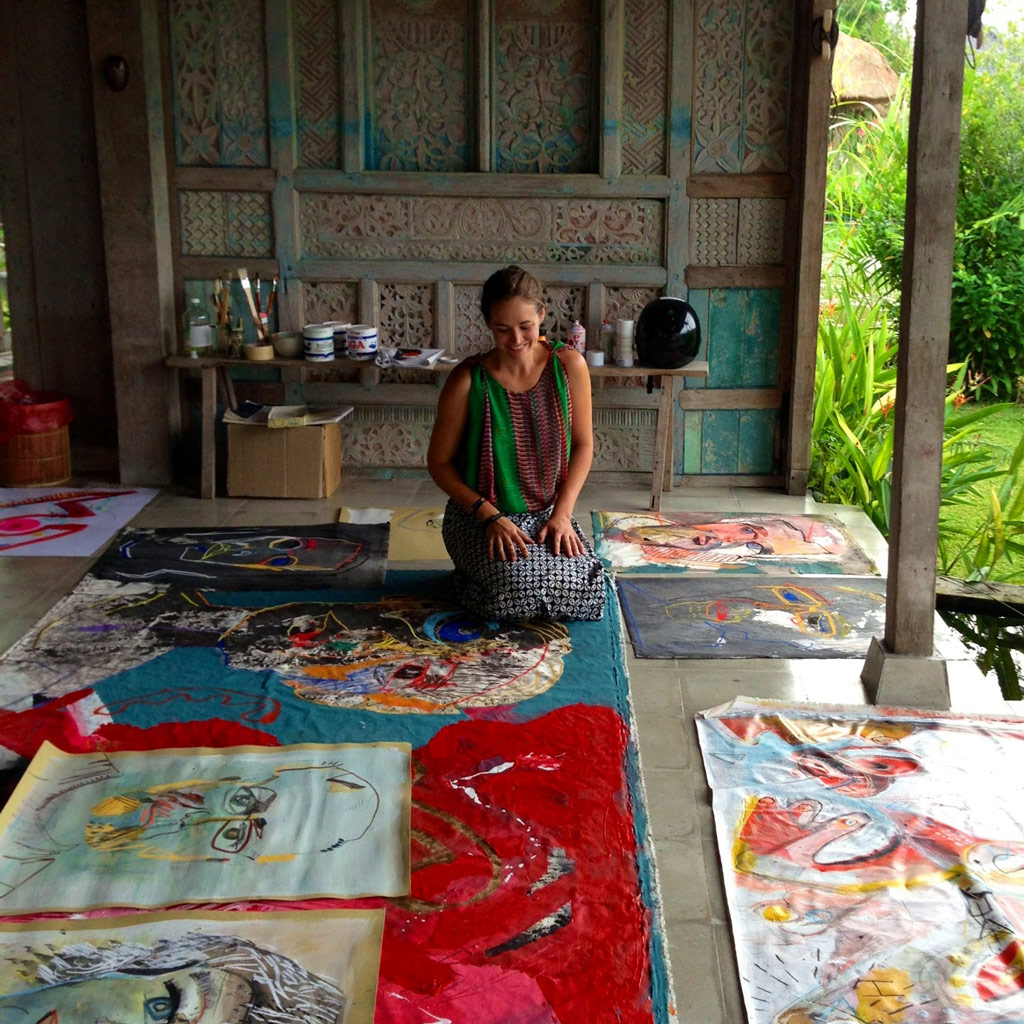
“…when you step into unchartered territory, you are also stepping into total abandonment, potential humiliation, and a space where nothing is guaranteed; there’s no case study or roadmap…And it’s scary and exciting as all hell.”
The next question deals with risk. You’ve already recounted a lot of your story and it seems like you’ve taken some big risks. Is there anything that stands out?
I believe that when you step into unchartered territory, you are also stepping into total abandonment, potential humiliation, and a space where nothing is guaranteed; there’s no case study or roadmap. I have so much respect for anybody who will step away from what they can do in order to find what they must do. That’s a hallmark characteristic of entrepreneurs and artists. And it’s scary and exciting as all hell.
Can you imagine if everyone followed their calling? Have you seen Stefan Sagmeister’s talk about this? He defines the difference between a job, a career, and a calling. I think there’s an important journey that each person should go on to at least figure out what their calling is, even if they don’t pursue it 9 to 5. Because it would be a tragedy if we all assumed our jobs were our callings, as that is not always the case. Right now, I’m trying to find my calling.
This is a good time to interview you, then. Outwardly, what you’re doing might seem crazy, but it’s not. You’re exploring things that most people are afraid to explore—things that are outside of the safety zone of a regular job.
Let’s meet in a year and see if I’ve figured it out.
No, you’ll be fine. People who take risks are the people who are interesting. That’s how you figure out more about what’s inside of you: by taking risks. People who are willing to really live might fail or be super successful, but if they’re living and feeling something, then that’s what matters.
I saw a quote once that hit right there. It was, “I don’t just want to live the length of my life. I would like to live the width of it as well.” I loved that. I think this is what happened at Mailbox. It was so well-received and every goal we had dreamed of was exceeded. It was great, but once I started really asking, “What is the truest, most authentic expression of who I am as a human being? What is that gift?” then that changed everything. The reason I went to Bali was because a girlfriend told me that everyone there was an artist. I took her literally. I showed up in Ubud, in the back of a car, like a child, with my hands and nose pressed against the window asking aloud, “Is she a sculptor? Is he a painter?” And by the end of my time in Ubud, an amazing thing happened. I began to wonder, “What if we went through life assuming that everyone actually was an artist? That everyone had an offering to give? To share?” Let’s broaden that up a little and ask, “What if everyone has a gift inside of them, a unique gift to give the world?”
I know there’s a question you ask about legacy, and I want to jump to it. Is that okay?
Go for it.
I love the idea that everyone has a gift to give. And I believe that the whole world is waiting for us to give that gift to them. What if we could empower everyone to operate out of that place, instead of out of job titles or money or security, even? Imagine a world where everyone gives their truest, most authentic gifts.
Everyone has something to give and contribute, and everyone can create, even if they don’t think of themselves as creative.
Yes! Wouldn’t the world be such a beautiful place if our callings were our careers were our jobs?
I think they can be. I think there will always be people who don’t realize their full potential, but—
We’ve got one shot at this life thing.
Yeah. Nobody really knows what happens when we’re dead and gone. You have to live to the fullest and go out with your hair on fire.
Yes, but it’s scary to say goodbye to the structure and systems and prizes that keep us afloat in good times and in bad, and say hello to that potential abandonment, fear, and humiliation. There’s another amazing quote, and I think it’s by Carl Jung: “It takes psychological readiness to see the path and courage to continue to walk it.” It takes a great deal to choose to do that. Once you do decide to take that leap, you need mentors and guides. Taking the leap is the greatest gift I’ve ever given myself. It’s funny to go give talks because I don’t have any answers, only questions. But I feel like, if we can encourage people to do this heart-led, soul-led work, then it will be unbelievable.
“I love the idea that everyone has a gift to give. And I believe that the whole world is waiting for us to give that gift to them. What if we could empower everyone to operate out of that place, instead of out of job titles or money or security, even? Imagine a world where everyone gives their truest, most authentic gifts.”
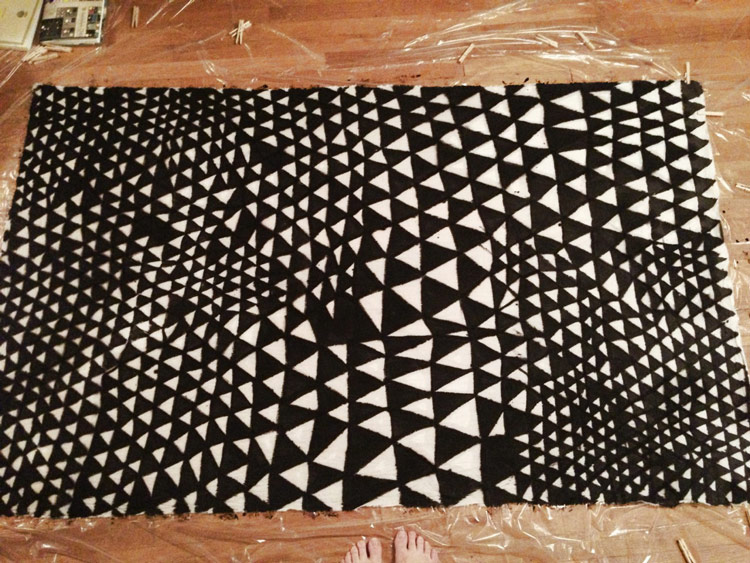
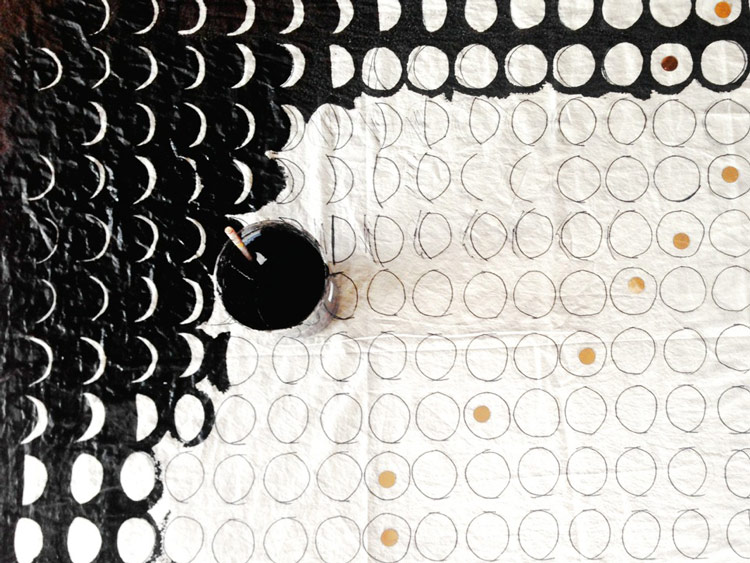
Are your family and friends supportive of what you do?
They are the sustaining force behind everything that I do.
Nice.
Going back to what I said before about it taking psychological readiness to see the path and courage to stay on it—my family and friends have that courage for me on days when I don’t have the courage to do it because it’s lonely and hard. I have them to thank for that. We can’t do this on our own, right?
Do you feel a responsibility to contribute to something bigger than yourself?
Absolutely. I feel like it’s our job to create something of meaning for others. How might we each find our gifts personally and offer them up to our community in the form of our work?
This is my favorite question. Are you creatively satisfied?
Absolutely and never. Fully and not at all. This is a total paradox. You need both parts. You can never be fully satisfied, and that’s what keeps you hungry, but you also need to know what good looks like, and you need to recognize when you’ve arrived in that place.
That’s good.
Everything is a paradox. I feel like I’m on a path I’ve never seen before, yet I’m not on a path at all. There’s no prescription for where I’m going, yet many people have been down this road. I contain so many paradoxes simultaneously, yet they all exist congruently.
So is there stuff you want to do in the next 5 to 10 years?
I’m kind of guns a blazing today. I have a friend who once said, “Well, if I live to be 40…” And I thought, “What do you mean? You’re already 32.” He said, “Well, nothing is guaranteed.” Yesterday morning at 3:55am, I received a text message from that friend that I would like to read to you. It said: “Life is so incredibly rich and so elusively ephemeral. Make sure you spend today like it’s the only day you’ll ever have.” I woke up at 5:30am, saw that message, and proceeded to totally freak out about my friend.
After I found out that my friend was okay, I asked myself what I’d do if today was my last day. So I got up and I went over to the Brooklyn Bridge and walked it at sunrise; then I went to Williamsburg and got a cappuccino; then I called my mom; then I went to a coffee shop and worked on this project that has been eluding me; then I went over to the garment district and met with the people who could help make that project happen. Later, I went to a Fast Company awards ceremony where I asked myself, “If this was my last day on earth, would I really be at an awards ceremony?” Maybe not, but maybe there are people here who are totally amazing, I thought. I ended up having a chat with the editor at Fast Company about publishing and vulnerability. I told him about the text I got and he asked what was left on my list for the day. I told him I felt like I just wanted to give people hugs. I asked him if I could give him a hug and he said yes. Then I went out to dinner with my friends and gave all of them hugs, too. I feel like everyone in life just needs more hugs.
If you could give advice to someone starting out, what would you say?
I would ask, “Who wants you to do what you’re about to do?” Do you feel like you want to do it or you ought to and should do it?—ought to and should are red flags. Oh, and if you preface anything with, “Hey Elle, this is probably a weird idea,” then I’ll probably tell you that you should go for it.
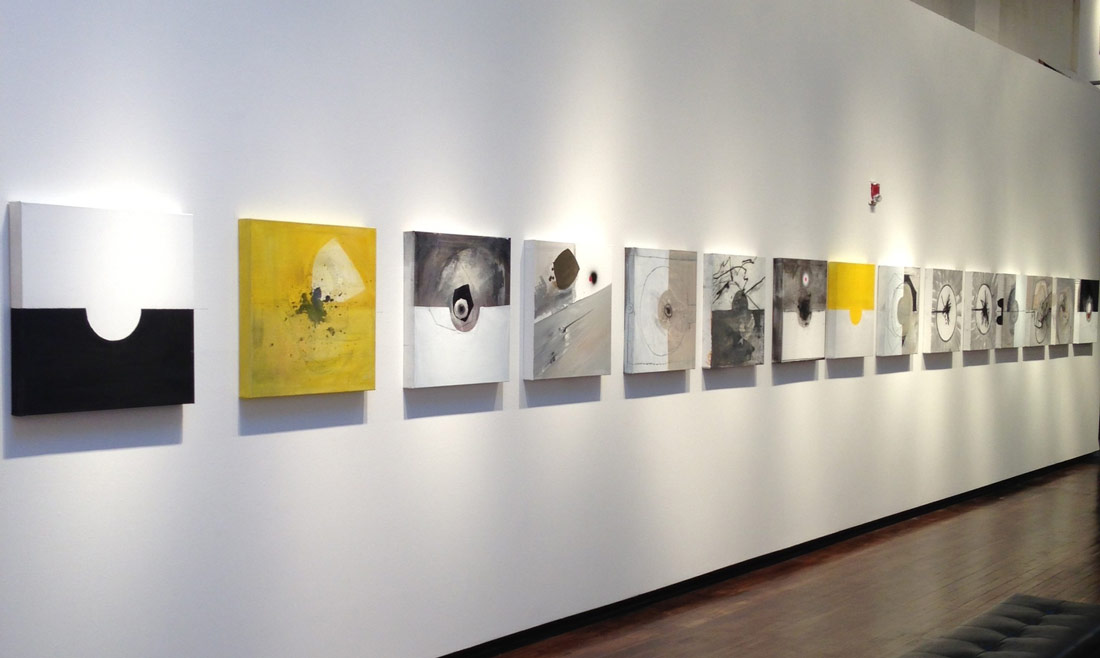
“…once you quit the job that’s paying the bills, the entire universe comes out to meet you. But it’s only after you quit your job that those people arrive, and that’s the secret that nobody knows.”
That’s good advice. You’re in San Francisco right now. How does living there impact your creativity?
So much. I love San Francisco. I feel like I will always have one foot firmly rooted there, and the other in an Airbnb. I love that San Francisco is such a weird place. You can do anything there and there’s this spirit of people helping one another that borders on the miraculous. San Francisco is an essential part of how and why I work the way I do, but I think getting outside of San Francisco often is also key. It’s too easy to get into the tech, early adopter mindset there. It’s refreshing to go somewhere and have people ask what the Cloud is.
Is it important to you to be part of a creative community of people?
I would die if I didn’t have that. I think that once you quit the job that’s paying the bills, the entire universe comes out to meet you. But it’s only after you quit your job that those people arrive, and that’s the secret that nobody knows. When you’ve made the leap and you’re far from shore, nothing is guaranteed, but we do it together and that’s what makes it worth it.
The power of community.
Yes. Because with all of their encouragement and support, you actually find yourself thinking, “I can totally do this.”
Now we’re on to the fun questions, and you already tackled the legacy question, so there are no serious ones left. What does your typical day look like?
I don’t have a typical day. Should I just say what I did today?
Sure.
I have, what I like to call, the bohemian day. It is intentionally unplanned. Because when your work is heart-led, you have a very fluid relationship with it. I wake up, hold the intention, and whatever comes forward is what I work on. For a long time, this didn’t adhere well to schedules or plans or deadlines. And now I’m beginning to see that I won’t always be in that phase, but I was for the last several months. This means it’s no longer work over here and life over there—it’s all one in the same.
What music are you listening to right now?
The High Highs, lots of Philip Glass and Gonzales, lots of jazz—like Ornette Coleman—and I’m on Rdio a lot, getting my Rihanna on.
Do you have any favorite TV shows or movies?
I don’t watch TV.
I like to go to the movie theater in the middle of the day and eat popcorn. Seeing a movie and eating popcorn in the middle of the day feels like I’m breaking all the rules and I love that.
Your favorite book?
If it’s art related, creative partnership related, or a children’s book, I like it.
What is your favorite food?
I would say local, organic food that’s simply prepared—also known as Piccino, one of my favorite restaurants in San Francisco.
You already answered the legacy question—
To inspire people to follow their calling, to show people that it’s possible and that it’s worth trying to find. There are so many people who have so much goodness in them that they want to express. If in any way, shape, or form I can inspire someone to take one step toward that, then that would be life-affirming.
So, you answered that question twice. I’ll let Tina decide what to do with it.
(speaking into the recorder) Bye, Tina.
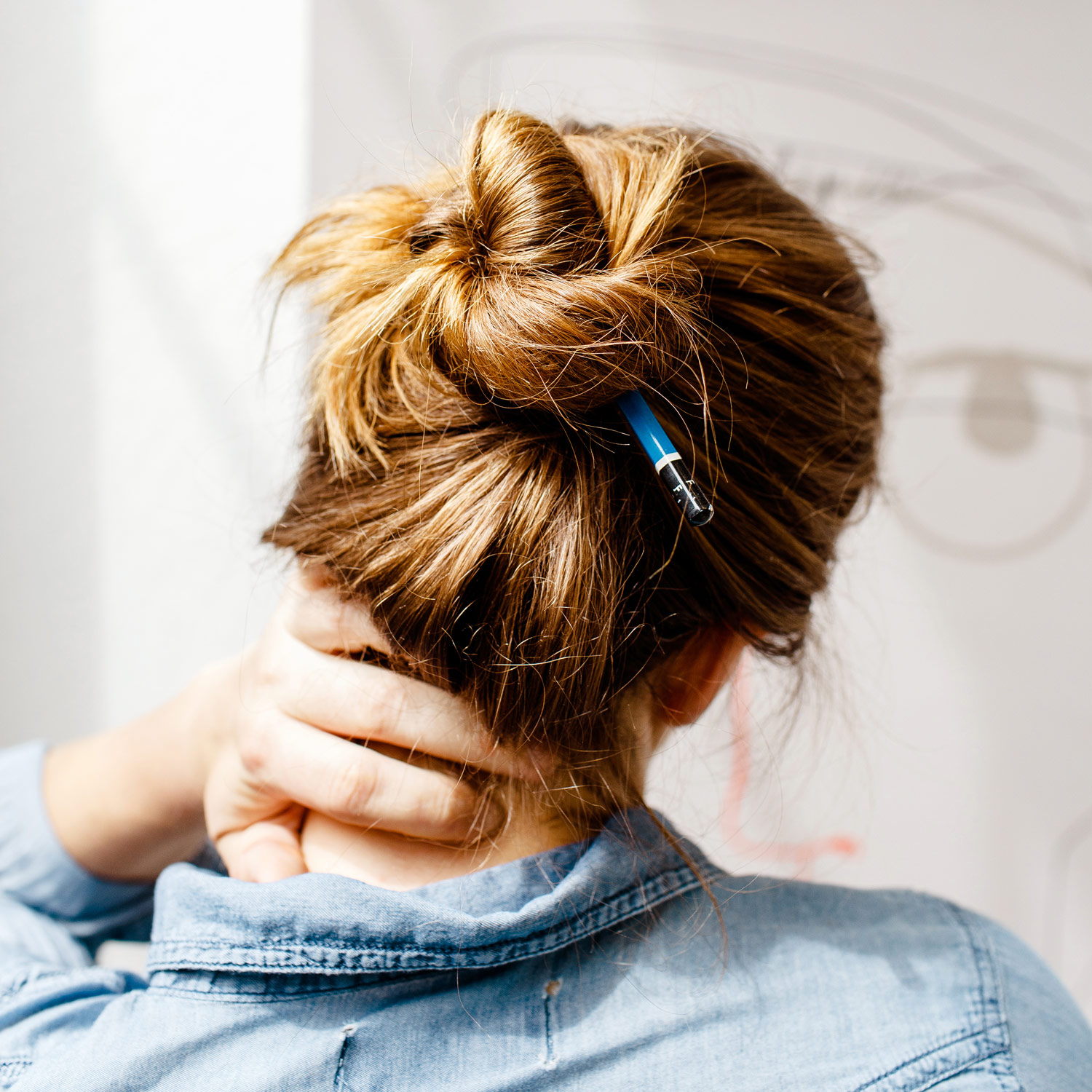
“There are so many people who have so much goodness in them that they want to express. If in any way, shape, or form I can inspire someone to take one step toward that, then that would be life-affirming.”